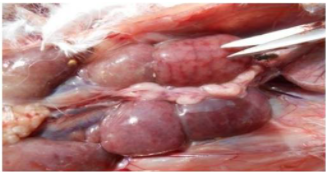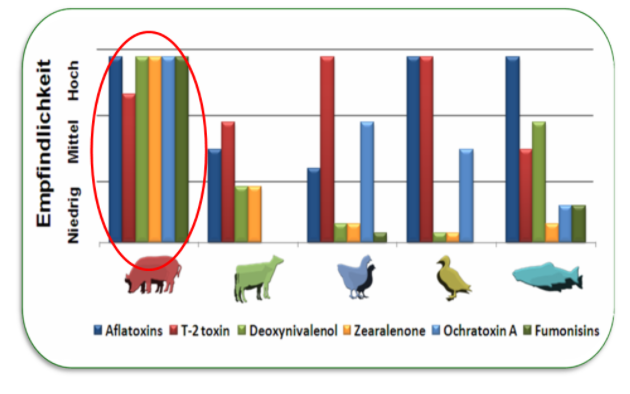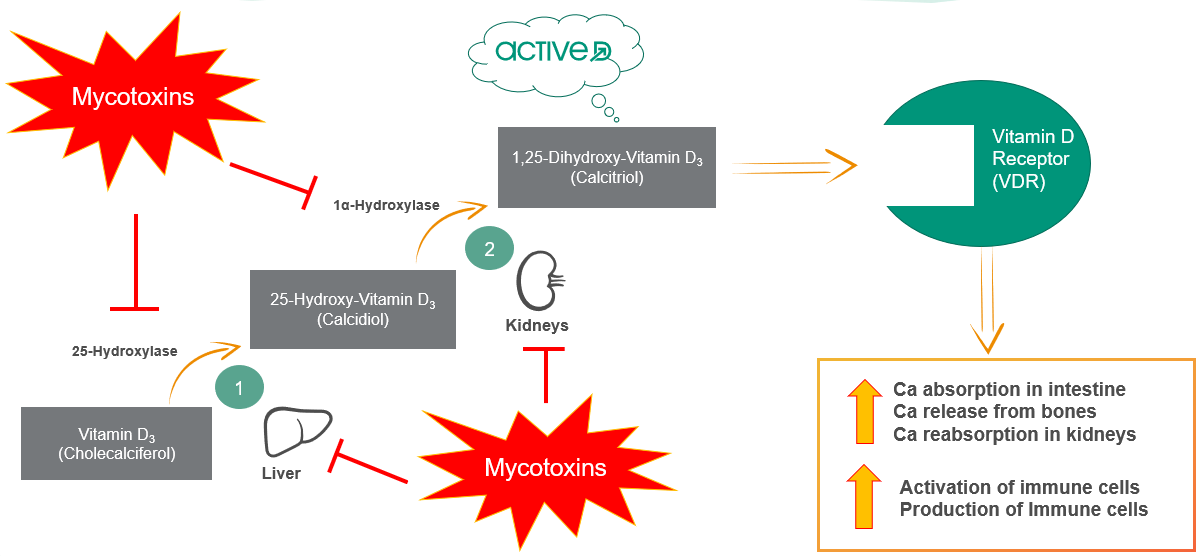How Active D helps to maintain Performance and Persistence
Mycotoxins - What is it and where is the challenge
Mycotoxins are toxic secondary metabolites produced by certain types of fungi, primarily molds, that can contaminate food and feed crops. These toxins are naturally occurring and can pose significant health risks to humans and animals if consumed in sufficient quantities. This fungal contamination is a global concern in agriculture and food safety. Mycotoxins can contaminate crops during cultivation, harvesting, transportation, and storage. Factors such as temperature, humidity, and poor storage conditions can promote mold growth and mycotoxin production. There are many different types of mycotoxins, some of the most well-known ones are aflatoxins, ochratoxins, fumonisins, deoxynivalenol (DON or vomitoxin), and zearalenone.
Each mycotoxin has its own unique properties and can affect various organ systems, especially in animals. Climate conditions, including temperature and humidity, can influence the prevalence of mycotoxins in crops. During periods of high rainfall, especially during the harvest season, mycotoxin levels in crops can increase sharply, which in turn poses challenges for both feed producers and animal feeders. Postharvest mitigation strategies are an important and cost-effective method to control the cause. The core grain postharvest interventions used as mitigating strategies of mycotoxin includes rapid and proper drying, postharvest insect control, proper transportation and packaging, good storage conditions are often not sufficient to achieve safe levels of mycotoxins in feed. Especially in 2023 European feedstuffs are at risk from mycotoxins due to challenging summer weather and due to actual climate change it will continue to be an emerging issue.
The underestimated risk for the animal
Mycotoxins in feed can have a significant impact on the health and performance of livestock. Here are some examples how mycotoxins in feed can affect livestock health:
- Reduced Feed Intake: Mycotoxins can make feed unpalatable, leading to reduced feed intake by animals. This decreased consumption can result in slower growth rates, lower weight gain, and reduced milk or egg production in livestock.
- Immunosuppression: Mycotoxins can weaken the immune system of animals, making them more susceptible to diseases and infections. This can increase the need for antibiotics and veterinary care, which can add to production costs.
- Liver and Kidney Damage: Mycotoxins like aflatoxins and ochratoxins can damage the liver and kidneys in animals. Chronic exposure to these mycotoxins can lead to long-term health problems.
- Reduced Reproductive Performance: Certain mycotoxins, such as zearalenone, can disrupt the reproductive system in animals. In females, it can lead to infertility, abortion, and stillbirths, while in males, it can cause reduced sperm production and motility.
Overall, mycotoxins in feed represent a significant challenge for livestock producers, and careful management practices are essential to minimize their impact on animal health and productivity.

Picture 1: Enlarged, swollen and pale kidney of a hen
due to Mycotoxins in feed (Hassan et. al., 2019)

Picture 2: Sensitivity of livestock to mycotoxins.
Especially pigs are affected (Source: PIGS XL - https://pigsxl.de/).
The impact on calcium, phosphorus and vitamin D metabolism
Mycotoxins, while primarily known for their toxic effects on various organ systems, can indirectly impact vitamin D and calcium metabolism in animals. It's important to note that the specific effects of mycotoxins on calcium and vitamin D metabolism can vary depending on the type of mycotoxin, the level of exposure, and the species of the affected organism. Additionally, the effects of mycotoxins on these processes are often indirect, resulting from the overall disruption of health and normal physiological functions.
Let’s start with the effect of mycotoxins on calcium absorption and metabolism. Mycotoxins, particularly those that cause digestive issues or damage to the gastrointestinal tract, can interfere with the absorption of essential nutrients, including calcium. Reduced calcium absorption can lead to imbalances in calcium metabolism, and thus to a mild hypocalcemia (low blood calcium levels). Simultainously, mycotoxins affect also the vitamin D metabolism, which strongly controls calcium absorption. Mycotoxins that affect liver function or impair the production of certain enzymes involved in vitamin D activation may indirectly disrupt calcium homeostasis.
As vitamin D plays an important role in in the immunity of the animals, the effect of mycotoxins on the immune system shouldn’t be underestimated. Some mycotoxins can weaken the immune system, which may lead to increased susceptibility to infections and inflammatory conditions. A deficiency of vitamin D can impair immune function. Therefore, mycotoxin-induced immunosuppression may exacerbate the effects of vitamin D deficiency.
Disrupted calcium metabolism can have negative effects on bone health. Chronic exposure to mycotoxins, especially those causing digestive and liver issues, can lead to weaker bones, which may be further exacerbated if there is also a deficiency in vitamin D, as vitamin D is essential for bone health. Also, it is important to mention the effect of several mycotoxins on hormones like parathyroid hormone (PTH), which play a key role in regulating calcium levels in the body. An imbalance in these hormonal systems can affect calcium and vitamin D metabolism.
How Active D helps to mitigate the impact of mycotoxins on calcium and vitamin D metabolism
Active D contains already activated form of vitamin D (1,25-Dihydroxy-Vitamin D3). This most active form of vitamin D doesn’t need to be converted in liver and kidneys or doesn’t need converting enzymes to be converted to its active form. The main benefit is the bypass of vitamin D metabolism and the possibility to quickly bind to vitamin D receptor to unfold the effect on calcium absorption and immunity (Illustration 1).
In practice, Active D can be used wherever mycotoxin binders are used. It is an alternative when the disadvantages of mycotoxin binders outweigh the benefits. Mycotoxin binders are not equally effective against all types of mycotoxins. They tend to be more effective against specific mycotoxins like aflatoxins and less effective against others like fumonisins or trichothecenes. Using a single binder may not provide comprehensive protection against all mycotoxins present in feed. Additionally, Mycotoxin binders can bind not only mycotoxins but also other nutrients and feed additives. This can reduce the bioavailability of essential nutrients, such as vitamins and minerals, in the feed, potentially leading to nutritional imbalances.
On the other hand, Active D offers benefits that mycotoxin binders cannot provide. It is a systematic bypass effect to maintain the availability of vitamin D and thus calcium absorption during periods of stress. It does not bind nutrients but increases their availability, as it has activated vitamin D as well as triterpenes that support intestinal integrity, thus supporting the absorption of nutrients and increasing digestibility.
Subclinical mycotoxin-poisoning damages major organs such as the liver and kidneys. This damage is often unnoticed but causes a steady decline in performance. Since Active D does not need these organs, this decline in performance can be slowed down. It is another alternative that can be considered along with many other mycotoxin control measures and can be a part of strategies to manage the problem.

Illustration 1: The effect of mycotoxins on the vitamin D metabolism.
Mycotoxins are damaging liver and kidneys and decrease the
production of converting enzymes which are involved in the metabolism.
As Active D
Active D - Targeted Approach
Supplying large amounts of vitamin D in the feed does not necessarily translate into increased performance, as it does not necessarily ameliorate possible Ca and P-related disorders. In other words, the vitamin D content of the feed on its own provides no indication of how well the animal can make use of it. In laying hens, the vitamin D content of the feed is fixed throughout the entire production by local legal regulations. This does not reflect the decreasing metabolic functioning of the organs in the later stages of laying. Additional stress factors inhibiting calcium and phosphorus metabolism, such as heat stress or glucocorticoid release, also affect the utilization of vitamin D. In these challenging situations, bio-active vitamin D from phytogenic sources may be the solution. This form has the benefit of being directly available to the organism. Furthermore, it can be simply used ‘on top’ of the standard cholecalciferol in the feed. Consequently, organs are relieved, and a continuous vitamin D supply is guaranteed. Importantly, when supplementing bio-active vitamin D, attention needs to be paid on the dose, to avoid counterproductive effects. The benefits of the bio-active and plant-derived form of vitamin D have been scientifically proven. Studies showed improved eggshell quality, maintained laying performance and modulation of the immune system, resulting in improved feed conversion.



















